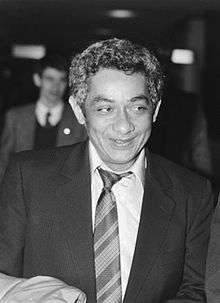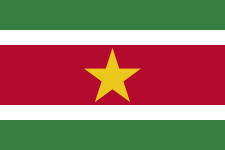President of Suriname
| President of Suriname
President van de Republiek Suriname | |
|---|---|
|
Standard of the President of Suriname | |
| Residence | Presidential Palace |
| Term length | Five years, renewable |
| Inaugural holder | Johan Ferrier |
| Formation | 25 November 1975 |
| Website | |
 |
| This article is part of a series on the politics and government of Suriname |
|
Politics portal |
The President of the Republic of Suriname (Dutch: President van de Republiek Suriname) is, in accordance with the Constitution of 1987, the head of state and head of government of Suriname, and commander-in-chief of Military of Suriname.
The current President is Dési Bouterse, a former army officer and military dictator. He is affiliated with the National Democratic Party. Bouterse was elected on 19 July 2010 and inaugurated on 12 August at the Anthony Nesty Sporthal (formerly known as National Indoor Stadium).
History
The office of President was created upon independence from the Netherlands in 1975. Until 1987, the role was largely ceremonial. The first officeholder was Dr. Johan Ferrier, a schoolteacher and veteran politician who had served as governor since 1968. He resigned as president in August 1980, several months after a coup d'état. From then until 1988, the titular Presidents were essentially army-installed puppets of Lt. Col. Bouterse, who ruled as a dictator with few practical checks on his power. Democracy was restored in 1988, the year after the adoption of the constitution, in which the duties and responsibilities of the president were included. On December 24, 1990, two days after Bouterse's resignation as army commander, the army called president Ramsewak Shankar to inform him that he and his cabinet were removed from office. Police Chief and Acting Commander of the army, Ivan Graanoogst was appointed Acting President. On December 27, 1990, Johannes Kraag became the president. Since 1991, the president is elected democratically.
Election
The President and a Vice President are elected by the National Assembly to a five-year mandate and are accountable to the Assembly. During his time in office, the President must forfeit any additional posts in politics or business.
Qualification
A candidate must be a Surinamese national (resident in the country for at least six years) who is at least 30 years of age. A candidate must win at least two-thirds of the votes in the Assembly to be elected. If no candidate wins two-thirds after three rounds, the vote then goes to the United People's Congress, composed of the Assembly and local government officials. In this case, a simple majority is required.
Powers and duties
The President is vested with extensive functional powers. The President names and dismisses ministers, signs bills, and names and dismisses diplomatic staff. He declares war and states of emergency with the ratification of the National Assembly. He concludes foreign treaties and agreements, again with the assent of the Assembly. He also exercises ceremonial duties such as conferring awards, receiving foreign diplomats, and granting pardons.
List of Presidents of Suriname
| № | Picture | Name (Birth–Death) |
Took office | Left office | Party |
|---|---|---|---|---|---|
| 1 | .jpg) |
Johan Ferrier (1910–2010) |
25 November 1975 | 13 August 1980 (resigned after a February coup d'état) |
Independent |
| 2 |  |
Hendrick Chin A Sen (1934–1999) |
15 August 1980 | 4 February 1982 | PNR |
| 3 | Fred Ramdat Misier (1926–2004) |
8 February 1982 | 25 January 1988 | Independent | |
| 4 |  |
Ramsewak Shankar (1937–) |
25 January 1988 | 24 December 1990 (deposed) |
VHP |
| 5 | .jpg) |
Johan Kraag (1913–1996) |
29 December 1990 | 16 September 1991 | NPS |
| 6 |  |
Ronald Venetiaan (1936–) |
16 September 1991 | 15 September 1996 | NPS |
| 7 |  |
Jules Wijdenbosch (1941–) |
15 September 1996 | 12 August 2000 | NDP |
| (6) |  |
Ronald Venetiaan (1936–) |
12 August 2000 | 12 August 2010 | NPS |
| 8 | Dési Bouterse (1945–) |
12 August 2010 | Incumbent | NDP | |
| Parties: National Democratic Party (NDP), Nationalist Republican Party (PNR), National Party of Suriname (NPS), Progressive Reform Party (VHP) | |||||
Latest election
See also
External links
- (Dutch) Kabinet van de President van de Republiek Suriname
- (English) Constitution of the Republic of Suriname, 1987
| |||||||||||||||||||||||||||||||||||||||||
| ||||||||||
| ||||||||||
| ||||||||||

